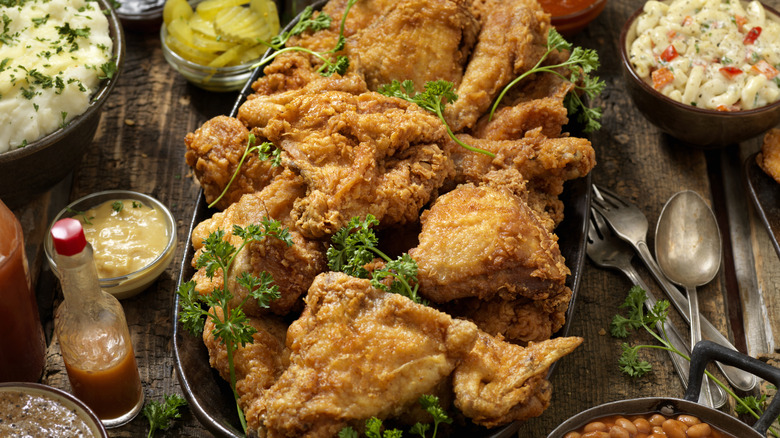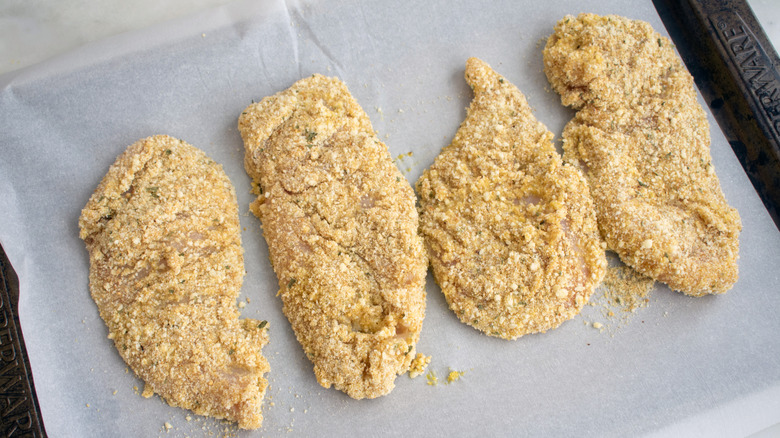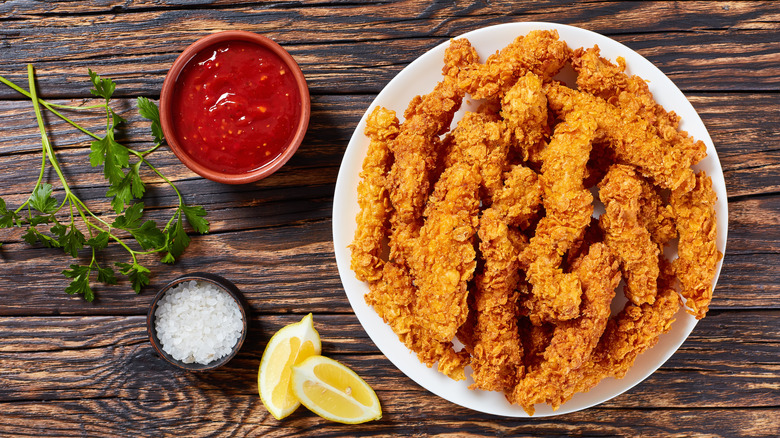Stop Breadcrumbs From Falling Off Your Chicken With One Extra Step
With its crunchy golden exterior and juicy tender meat, crispy-crumbed chicken is always a treat. But sometimes you can prepare it with great care and still find that the breadcrumbs fall right off, which is incredibly frustrating. While there are several ways to help the crumbs stick better, from making sure the meat is dry to dredging it, there's one extra step you may have missed: You need to chill the breaded chicken before you fry it.
The other stages are important, too, so if you're wondering why your chicken breading won't stick and how to fix it, there could be several reasons, since preparing breaded chicken is all about the technical process. In many ways, it can resemble a mini production line, using one hand for the seasoned flour and the other for the egg wash and breadcrumbs, so everything doesn't become a sticky mess. But if you're putting the breaded chicken straight into hot oil without chilling it first, even though it may look well-coated, there's a good chance the crumbs will just slide off, leaving a pan of burnt crumbs floating about and the meat looking decidedly bare.
While it does mean that making dinner can take a little longer, the extra few minutes in the refrigerator is key to help the coating set and stick effectively. So whether you're making homemade chicken katsu or crispy schnitzel, don't skip the chilling stage if you want the best results every time.
15 minutes in the fridge helps the breadcrumbs to set
Flouring the chicken before dipping it in egg wash helps the sticky coating adhere to the dry pieces of meat, and the gluey egg and flour combo in turn helps the breadcrumbs to stick better. But what it means is that the coating itself is rather wet. The chilling stage helps to ensure that the flour absorbs this additional moisture, which comes from both the egg and the chicken itself, so that the crumbs stick better to the pieces of chicken, almost cementing them in place before they're cooked.
The poultry doesn't need a long time in the fridge for the coating to set; just 15 minutes is enough for the mixture to become solid enough to cling. Once you've applied the breadcrumbs, just transfer the pieces to a cooling rack or tray, and pop them in the refrigerator for at least a quarter of an hour, and up to 30 minutes.
However, it's not advisable to then cook the chicken straight from the fridge, as the cold temperature means it could remain undercooked in the center even though the crumb looks golden brown; another problem is that it can drop the temperature of the cooking oil, so you end up with greasy, rather than crispy, chicken. So you'll actually need to leave it out of the fridge for another 15 minutes or so to get it back to room temperature before frying.
How to elevate your breading for a tasty crispy crumb
Once you're confident that the crumbed coating will actually stay on the chicken thanks to the chilling method, it's well worth playing around with different breadcrumbs or other alternatives to switch up the taste and texture. Japanese-style panko breadcrumbs are perfect for giving the ultimate crunch since they are dried, which is one of the reasons why panko and breadcrumbs are not interchangeable in many recipes. But if you want to experiment with different crumbs, it's easy to add your own spin on breaded chicken with other ingredients.
If you're making breadcrumbs, then try adding extra seasonings and herbs to really ramp up the taste. Blitzing cubed Italian bread in a food processor with garlic powder and dried herbs such as parsley, oregano, thyme, or rosemary can add an injection of aromatic flavor, with perhaps a little lemon zest for added brightness, or Parmesan for an umami hit. Or try adding spices like red pepper flakes, ground ginger, or cayenne pepper for a hotter crumb. And it's also possible to make your own breadcrumbs without a food processor, so don't worry if you don't have one; try a cheese grater instead.
Alternatively, ditch the bread, and try breakfast cereal. Crushed cornflakes are especially good at producing a crispy crumb that is much less likely to go soggy. Or try crushed pretzels, crackers, or even your favorite chips for a unique crunchy finish.



